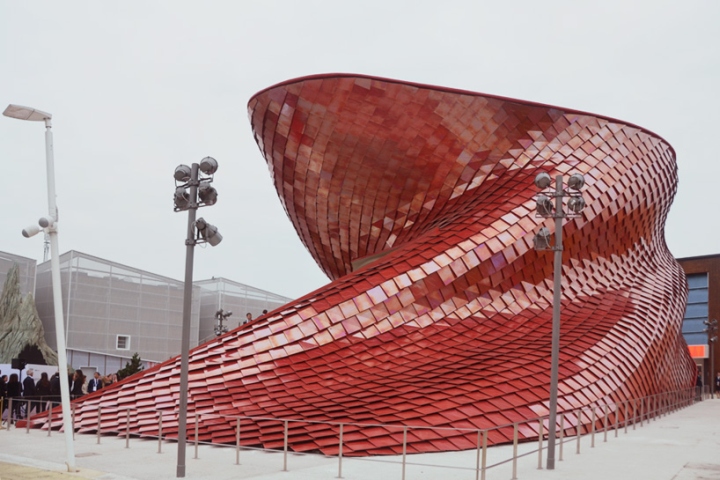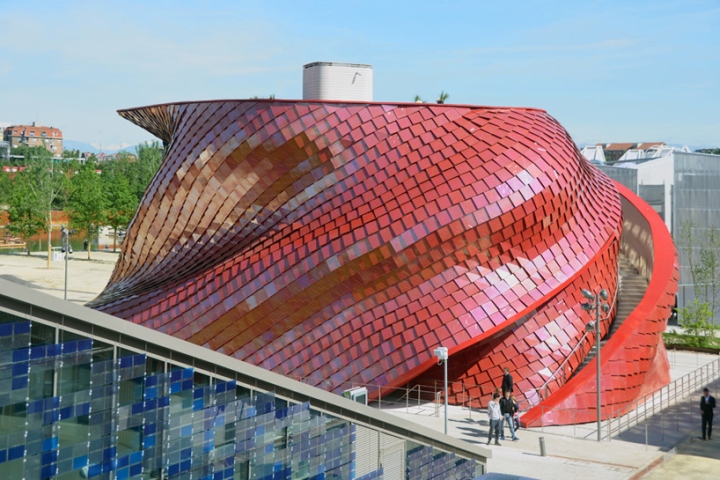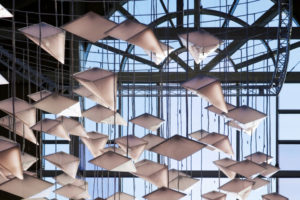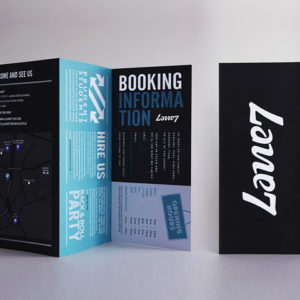


Designed by renowned architect Daniel Libeskind, the corporate pavilion for Vanke China seeks to explore key issues related to the theme of Milan’s Expo 2015 – ‘Feeding the planet, energy for life’. the concept for the temporary pavilion incorporates three ideas drawn from Chinese culture related to food: the Shi-tang, a traditional Chinese dining hall; the landscape, the fundamental element to life; and the dragon, which is metaphorically related to farming and sustenance. To understand more about the design, Designboom spoke with Daniel Libeskind, who talked in more detail about his approach to the project.

Situated on the southeast edge of the lake arena, the 800-square meter pavilion appears to rise from the east, forming a dynamic, vertical landscape. the design features a sinuous geometrical pattern that flows between inside and out, while a grand staircase – clad in warm grey concrete – carves through the red serpentine form and guides visitors to the upper level. A roof-top observation deck with a planted garden provides views of the lake and nearby Italian pavilion.

The pavilion is clad with more than 4,000 red metalized tiles that Libeskind designed with the Italian company Casalgrande Padana. The geometric ceramic panels not only create an expressive pattern that is evocative of a dragon-like skin, but also possess highly sustainable self-cleaning and air purification properties. The three-dimensional surface is coated with a metallic coloration that changes as light and viewpoints shift.

The tiles are installed with a state-of-the-art cladding support system that gives a rhythmic pattern and mathematical form to an otherwise supple, torquing shape. two spiraling stairs, echoing the form, ascend the pavilion to the south, and to the north from the lake arena entrance, serving both as circulation and seating. Inside the pavilion, visitors encounter an exhibition space filled with a constellation of 200 screens mounted to a matrix of bamboo scaffolding. The forest of screens and bamboo floats above a winding reflecting pool that borders the visitor pathway. As visitors move through the space, a ten-minute narrative experience unfolds across the screens and over 22 channels of audio.

The frenzy of life in the city is starkly juxtaposed with the extreme slow motion of a communal meal, first in its preparation and then in its consumption. In this way, the message—about the power and possibility to forge connections and build community through food—is meant to be understood more viscerally than intellectually. The top level of the pavilion provides a private space to accommodate small events and host VIPs. the intimate room features an open layout, a large skylight that ushers in natural daylight, Casalgrande Padana tiled flooring, bamboo veneer wall coverings and a dramatic hand-blown glass chandelier designed by Libeskind for the Czech artisanal glass company Lasvit. The interior exhibition design is led by Ralph Appelbaum Associates with graphic design by Han Jiaying.

As the rapid growth of cities forces populations to live in closer proximity and the risk of social disintegration rises, we commissioned this pavilion to address both metaphorically and physically the issues of contemporary life related to the theme of the expo,’ said Wang Shi, chairman of China Vanke. ‘The tradition of food in Chinese culture has many strong associations, from the concept of the shi-tang (dining hall) to the form of the dragon, which is mythically derived from the history of agriculture in China. Through these concepts we aim to represent Vanke’s goals on a global scale: the possibility to create vibrant, healthy communities in a sustainable and innovative environment,’ added chairman Wang.








via designboom













Add to collection










